Time to ‘manifest’ your way into your dream life!
June 8, 2022
While the mainstream high school stereotypes such as “jock,” “nerd” and “popular kid” have been around for ages, a newer label is capturing today’s teens: the “crystal girl.” In an age where the future is unpredictable, insecurities are high and self-esteem is low, these self-proclaimed “crystal girls” wear necklaces made of crystals and perform rituals with stones to control their auras and ensure a positive future in which everything they have ever wanted becomes a reality.
From this idealistic “crystal girl,” younger generations have developed a toxic dependence on manifestation. Consisting of various pseudoscientific self-help strategies intended to bring about a personal goal, manifestation focuses on one’s thoughts and desired outcomes. This is not a practice that comes with a click of a button, but rather a mental exercise that becomes easier and more effective when incorporated into one’s daily life. Though manifestation has become misunderstood in recent years, if done properly, it can have significant benefits to the overall happiness and success of a person’s life.
In order to alleviate the common misconception that manifestation isn’t effective, it’s important to note that manifesting consists of many different strategies. As a practice used to ensure personal goals, manifestation is an overarching umbrella for many individual tactics, such as the Law of Attraction and the Law of Assumption. These laws can be dated back to ancient times, and they are incorporated into different religions such as Buddhism and Christianity, evolving to become what they are today.
The Law of Attraction is a science in which someone’s negative or positive thoughts attract negative and positive experiences, respectively. Essentially, it’s the idea that a person’s thoughts can control the outcome of their desires. On the other hand, the Law of Assumption is assuming that one’s wishes have already been fulfilled, embracing how someone would feel if their manifestation became a reality in that moment. By embodying their dreams, people are now in the correct and healthy mindset to further their pursuit of happiness.
Manifestation as well as the Laws of Attraction and Assumption have recently become widespread, especially among today’s youth. According to the June Bark survey, 46 percent of Redwood students think that manifestation is sometimes effective, while 28 percent have said it’s useless. It’s clear that teenagers see a point to manifestation, but the 28 percent’s hesitation is important to recognize,, so it’s vital to instill and spread proper manifesting techniques. Participation in the trending “manifestation” from influencers on social media platforms such as Tik Tok has spiked, and many influencers are giving tips and tricks to their watchers — advice that might not actually work. Despite scams and biased celebrity opinions that deter some, manifestation itself can work, but only if continuously practiced with the effort to change one’s habits.
For the Law of Attraction and Law of Assumption to actually provide benefits, there are certain tasks that need to be completed over a substantial period of time. Practicing visualization, for example, can be anything from repeating a phrase in your head until you almost feel that it’s real or imagining yourself in the desired scenario achieving your goal. Cognitive reframing, however, is a little different and often can require the help of a therapist. According to Very Well Mind, “The essential idea behind reframing is that the frame through which a person views a situation determines their point-of-view. When that frame is shifted, the meaning changes and thinking and behavior often change along with it.” By altering someone’s attitude and energy from a more positive point of view, their newfound confidence is projected onto others.. By practicing visualization and cognitive reframing, a person can cultivate a more positive attitude and build up confidence which can change their energy and how they perceive their goals..
While the saying “the world is your oyster” may come off as a bit cliché, to a certain degree, it’s true. Life takes everyone on their own course, but it’s what a person makes of their path that determines how pleased they will be with their reality. Working for a goal may not bring the results one hoped for, but putting in the effort to understand how the brain functions, visualizing techniques, meditating, journaling and so much more can alter that course for the better, initiating a more positive mindset that can take someone one step closer to their dreams.






















